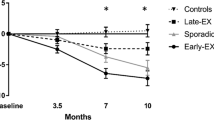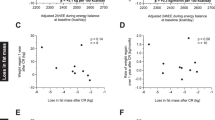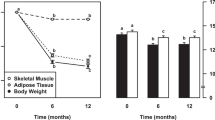Abstract
Background/objectives:
A decline in resting energy expenditure (REE) beyond that predicted from changes in body composition has been noted following dietary-induced weight loss. However, it is unknown whether a compensatory downregulation in REE also accompanies exercise (EX)-induced weight loss, or whether this adaptive metabolic response influences energy intake (EI).
Subjects/methods:
Thirty overweight and obese women (body mass index (BMI)=30.6±3.6 kg/m2) completed 12 weeks of supervised aerobic EX. Body composition, metabolism, EI and metabolic-related hormones were measured at baseline, week 6 and post intervention. The metabolic adaptation (MA), that is, difference between predicted and measured REE was also calculated post intervention (MApost), with REE predicted using a regression equation generated in an independent sample of 66 overweight and obese women (BMI=31.0±3.9 kg/m2).
Results:
Although mean predicted and measured REE did not differ post intervention, 43% of participants experienced a greater-than-expected decline in REE (−102.9±77.5 kcal per day). MApost was associated with the change in leptin (r=0.47; P=0.04), and the change in resting fat (r=0.52; P=0.01) and carbohydrate oxidation (r=−0.44; P=0.02). Furthermore, MApost was also associated with the change in EI following EX (r=−0.44; P=0.01).
Conclusions:
Marked variability existed in the adaptive metabolic response to EX. Importantly, those who experienced a downregulation in REE also experienced an upregulation in EI, indicating that the adaptive metabolic response to EX influences both physiological and behavioural components of energy balance.
This is a preview of subscription content, access via your institution
Access options
Subscribe to this journal
Receive 12 print issues and online access
$259.00 per year
only $21.58 per issue
Buy this article
- Purchase on Springer Link
- Instant access to full article PDF
Prices may be subject to local taxes which are calculated during checkout



Similar content being viewed by others
References
Schwartz A, Doucet É . Relative changes in resting energy expenditure during weight loss: a systematic review. Obes Rev 2010; 11: 531–547.
Tremblay A, Royer M, Chaput J, Doucet E . Adaptive thermogenesis can make a difference in the ability of obese individuals to lose body weight. Int J Obes 2013; 37: 759–764.
Major G, Doucet E, Trayhurn P, Astrup A, Tremblay A . Clinical significance of adaptive thermogenesis. Int J Obes 2007; 31: 204–212.
Dulloo A, Jacquet J, Montani JP, Schutz Y . Adaptive thermogenesis in human body weight regulation: more of a concept than a measurable entity? Obes Rev 2012; 13: 105–121.
Byrne NM, Wood R, Schutz Y, Hills AP . Does metabolic compensation explain the majority of less-than-expected weight loss in obese adults during a short-term severe diet and exercise intervention. Int J Obes 2012; 36: 1472–1478.
Flatt J . Exaggerated claim about adaptive thermogenesis. Int J Obes 2007; 31: 1626.
Schwartz A, Kuk JL, Lamothe G, Doucet E . Greater than predicted decrease in resting energy expenditure and weight loss: results from a systematic review. Obesity 2012; 20: 2307–2310.
Heilbronn L, de Jonge L, Frisard M, DeLany J, Larson-Meyer D, Rood J et al. Effect of 6-month calorie restriction on biomarkers of longevity, metabolic adaptation, and oxidative stress in overweight individuals: a randomized controlled trial. JAMA 2006; 295: 1539–1548.
Johannsen DL, Knuth ND, Huizenga R, Rood JC, Ravussin E, Hall KD . Metabolic slowing with massive weight loss despite preservation of fat-free mass. J Clin Endocrinol Metab 2012; 97: 2489–2496.
Rosenbaum M, Murphy EM, Heymsfield SB, Matthews DE, Leibel RL . Low dose leptin administration reverses effects of sustained weight-reduction on energy expenditure and circulating concentrations of thyroid hormones. J Clin Endocrinol Metab 2002; 87: 2391–2397.
Rosenbaum M, Goldsmith R, Bloomfield D, Magnano A, Weimer L, Heymsfield S et al. Low-dose leptin reverses skeletal muscle, autonomic, and neuroendocrine adaptations to maintenance of reduced weight. J Clin Invest 2005; 115: 3579.
Peronnet F, Massicotte D . Table of nonprotein respiratory quotient: an update. Can J Sport Sci 1991; 16: 23–29.
Compher C, Frankenfield D, Keim N, Roth-Yousey L . Best practice methods to apply to measurement of resting metabolic rate in adults: a systematic review. J Am Diet Assoc 2006; 106: 881–903.
Weir JBV . New methods for calculating metabolic rate with special reference to protein metabolism. J Physiol 1949; 109: 1–9.
Achten J, Jeukendrup AE . Maximal fat oxidation during exercise in trained men. Int J Sports Med 2003; 24: 603–608.
Matthews D, Hosker J, Rudenski A, Naylor B, Treacher D, Turner R . Homeostasis model assessment: insulin resistance and β-cell function from fasting plasma glucose and insulin concentrations in man. Diabetologia 1985; 28: 412–419.
Caudwell P, Finlayson G, Gibbons C, Hopkins M, King N, Naslund E et al. Resting metabolic rate is associated with hunger, self-determined meal size, and daily energy intake and may represent a marker for appetite. Am J Clin Nutr 2013; 97: 7–14.
Johnstone AM, Murison SD, Duncan JS, Rance KA, Speakman JR . Factors influencing variation in basal metabolic rate include fat-free mass, fat mass, age, and circulating thyroxine but not sex, circulating leptin, or triiodothyronine. Am J Clin Nutr 2005; 82: 941–948.
King NA, Hopkins M, Caudwell P, Stubbs R, Blundell JE . Individual variability following 12 weeks of supervised exercise: identification and characterization of compensation for exercise-induced weight loss. Int J Obes 2008; 32: 177–184.
Barwell N, Malkova D, Leggate M, Gill J . Individual responsiveness to exercise-induced fat loss is associated with change in resting substrate utilization. Metabolism 2009; 58: 1320–1328.
Church TS, Martin CK, Thompson AM, Earnest CP, Mikus CR, Blair SN . Changes in weight, waist circumference and compensatory responses with different doses of exercise among sedentary, overweight postmenopausal women. PLoS One 2009; 4: e4515.
Lecoultre V, Ravussin E, Redman LM . The fall in leptin concentration is a major determinant of the metabolic adaptation induced by caloric restriction independently of the changes in leptin circadian rhythms. J Clin Endocrinol Metab 2011; 96: E1512–E1516.
Doucet E, Pierre SS, Alméras N, Mauriège P, Richard D, Tremblay A . Changes in energy expenditure and substrate oxidation resulting from weight loss in obese men and women: is there an important contribution of leptin? J Clin Endocrinol Metab 2000; 85: 1550–1556.
Snitker Sr, Pratley RE, Nicolson M, Tataranni PA, Ravussin E . Relationship between muscle sympathetic nerve activity and plasma leptin concentration. Obes Res 1997; 5: 338–340.
Rosenbaum M, Kissileff HR, Mayer LES, Hirsch J, Leibel RL . Energy intake in weight-reduced humans. Brain Res 2010; 1350: 95–102.
Zurlo F, Lillioja S, Esposito-Del Puente A, Nyomba B, Raz I, Saad M et al. Low ratio of fat to carbohydrate oxidation as predictor of weight gain: study of 24-h RQ. Am J Physio- Endoc M. 1990; 259: E650–E657.
Seidell J, Muller D, Sorkin J, Andres R . Fasting respiratory exchange ratio and resting metabolic rate as predictors of weight gain: the Baltimore Longitudinal Study on Aging. Int J Obes Relat Metab Disord 1992; 16: 667–674.
Marra M, Scalfi L, Covino A, Esposito-Del Puente A, Contaldo F . Fasting respiratory quotient as a predictor of weight changes in non-obese women. Int J Obes Relat Metab Disord 1998; 22: 601–603.
Baak Mv . The peripheral sympathetic nervous system in human obesity. Obes Rev 2001; 2: 3–14.
Rosenbaum M, Hirsch J, Gallagher D, Leibel R . Long-term persistence of adaptive thermogenesis in subjects who have maintained a reduced body weight. Am J Clin Nutr 2008; 88: 906–912.
Kissileff HR, Thornton JC, Torres MI, Pavlovich K, Mayer LS, Kalari V et al. Leptin reverses declines in satiation in weight-reduced obese humans. Am J Clin Nutr 2012; 95: 309–317.
Acknowledgements
This research was supported by BBSRC grant numbers BBS/B/05079 and BB/G005524/1 (DRINC), EU FP7 Full4Health (266408) and the Stockholm county council (ALF).
Author information
Authors and Affiliations
Corresponding author
Ethics declarations
Competing interests
The authors declare no conflict of interest.
Rights and permissions
About this article
Cite this article
Hopkins, M., Gibbons, C., Caudwell, P. et al. The adaptive metabolic response to exercise-induced weight loss influences both energy expenditure and energy intake. Eur J Clin Nutr 68, 581–586 (2014). https://doi.org/10.1038/ejcn.2013.277
Received:
Revised:
Accepted:
Published:
Issue Date:
DOI: https://doi.org/10.1038/ejcn.2013.277
Keywords
This article is cited by
-
The Influence of Energy Balance and Availability on Resting Metabolic Rate: Implications for Assessment and Future Research Directions
Sports Medicine (2023)
-
Effects of a 4-month active weight loss phase followed by weight loss maintenance on adaptive thermogenesis in resting energy expenditure in former elite athletes
European Journal of Nutrition (2022)
-
The effects of exercise session timing on weight loss and components of energy balance: midwest exercise trial 2
International Journal of Obesity (2020)
-
Effect of Exercise Training on Non-Exercise Physical Activity: A Systematic Review and Meta-Analysis of Randomized Controlled Trials
Sports Medicine (2017)
-
Changes in Energy Expenditure with Weight Gain and Weight Loss in Humans
Current Obesity Reports (2016)



